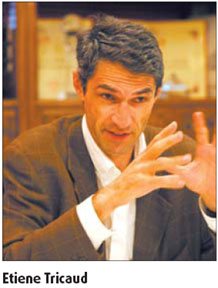French designer combines space and culture
In the eyes of French architect Etiene Tricaud, building design is how a space deals with the basic relationship between man and nature.
"From the early morning people are connected in places where their movements concentrate," said Tricaud, general director and architectural engineer of AREP, an architecture and town planning design firm.
"The comfort people have while moving and the meaning of architecture are key points architects have to consider to give simplicity to the complex."

The firm created by Tricaud and its president Jean-Marie Dthilleul in 1999 is well-known for building solutions and engineering that enables the flow and management of crowds, as well as the environment and comfort of places of transit.
Since 1998, it has been an avid supporter of Sino-French exchange projects, especially in architecture.
"What is Chinese architecture in modern society? It is not a question of style or image, but how to be a place where Chinese behave differently from other nations," said Tricaud.
"Chinese prefer a vertical opening to let light enter with the earth - the sky comes to the eyes with scenery that changes at the same time, like viewing an abstract Chinese painting - while French like the window to present a scene from which people can tell directly what's story is happening."
He noted that modern buildings should be grounded in traditional culture and localization is vital to AREP's presence in China. In 2006, the firm saw its first five Chinese developments in China - Beijing Capital Museum and the Xizhimen transport hub and business center in Beijing, TEDA financial center and Taifeng housing development in Tianjin, and Shanghai South Railway Station.
As one of the designers of the award-winning Western Ring Square in Beijing's Xizhimen transportation hub, Tricaud understood the landmark function played by the project. The concept of using three parts of the square is grounded in the appearance of Beijing's old city gates.
His projects are based on two principles: providing a new image for the city and incorporating human-oriented and eco-friendly features into building construction. In Beijing's urban setting, movements amply density to create an amenity that functions much like a city gate of old but with a resolutely contemporary character. The square is regarded as an excellent construction work that shows optimal use of metropolitan space.
Tricaud said he thinks the organization of space and layout of function, structure, geometry, material and colors should all create a space where people feel at home - a frame that creates a bond between people and their culture.
Every city has its own thoughts, emotions and memory. To create a public place with a strong identity, APEP's plan incorporated a complete consideration of the city's history, culture and natural resources.
When Tricaud supervised the construction of Shanghai South Railway Station, he knew that people move around the city by car and take an elevated highway, so his team incorporated a highway viaduct in its design that created an efficient system for cars and buses to drop off passengers and reduced the distance passengers need to walk to waiting areas or directly to train platforms.
It's great bicycle-wheel roof and sleek materials of brushed aluminum; glass, polycarbonate and perforated steel represent the city's leap into the 21st century.
Fascinated by traditional Chinese culture, the French architects on his team used various Chinese elements such as quadrangle layout, grey bricks and bronze in their designs.
The Beijing Capital Museum is an illustration of the approach. One of its designs, the 7,000-sq-m Treasure Gallery, is a bronze structure housing a large proportion of precious objects. It forms a cylinder leaning at an angle that meets the main, north-facing facade to give the entire building with its signature identity.
The museum, unlike some in the West, has extensive space for governments to organize indoor public events and performances in a large central atrium. The lift is hidden in a corner of the atrium, adapted to fit Chinese people's psychology of behaving indirectly. Yet the high artificial roof is unadorned, intended to represent the heaven for people to imagine.
"Although living in the midst of modernity, all Chinese retain in their memory, conscious or unconscious, a specific perception of space, of the relationship between full and empty, public and private, matter and light, heaven and earth," said Tricaud, drawing sketches of the museum to explain some of its layout.
In his spare time Tricaud is interested in creating Chinese ink paintings. In his extensive travels in China, a town with Ming Dynasty (1368-1644) architecture in An'hui province of east China greatly impressed him.
He shares ideas with his Chinese partners and colleagues to start a new project.
"They are more aware of culture and history, and more efficient and flexible," he said, adding that although they too have inspiration, they keep their focus primarily on China's traditional culture and on modern ways to translate it.
Influenced by his mother, also a famous architect, Tricaud aimed to follow in her footsteps as young as 6 years old. As a graduate in architecture from the University of Paris and engineering from the Ecole Polytechnique and Ecole Nationale des Ponts et Chaussees, he realized his dream across the world by completing many major international projects.
"Thanks to his wisdom and commitment, AREP has reaped rich benefits in China and made greater efforts to bridge Sino-French construction exchange," said Fleur des Digueres, general director of the AREP China branch.
(China Daily 10/24/2008 page42)














